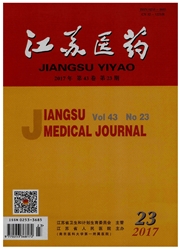

 中文摘要:
中文摘要:
目的探讨芍药苷(PF)对认知功能障碍小鼠记忆功能和海马神经因子的保护作用。方法60只小鼠随机均分为对照组(A组)、模型组(B组)、PF50mg/kg组(C组)和PF100mg/kg组(D组)。采用侧脑室内注射p淀粉样蛋白诱导认知功能障碍模型,Morris水迷宫检测空间认知功能,Y型电迷宫法检测学习和记忆行为,Westernblot检测海马区域的胶质原纤维酸性蛋白(GFAP)和生长相关蛋白43(GAP-43)的表达,ELISA法检测海马脑源性神经营养因子(BDNF)水平。结果与A组相比,B组训练3d后的登台潜伏期延长,站台所在象限停留时间缩短,学习次数增多,记忆次数减少,海马区域GFAP、GAP-43和BDNF水平降低(P〈O.05);而PF能有效改善B组各观察指标的改变过程(P〈O.05)。结论PF能改善认知功能障碍小鼠记忆功能,同时升高海马神经因子水平。
 英文摘要:
英文摘要:
Objective To investigate the protective effect of paeoniflorin(PF) on the ability of memory and learning and levels of hippocampal neurotrophic factors in mice with cognitive dysfunction. Methods Sixty mice were equally randomized into four groups of A(normal controls),B (cognitive dysfunction model),C(administrated with PF 50 mg/kg) and D(administrated with PF 100 mg/kg). The cognitive dysfunction model was established by intracerebroventricular injection of Aβ25-35. The space cognitive function and behavior of learning and memory were analyzed by Morris water maze and Y-maze, respectively. The protein expressions of hippocampal glial fibrillary acidic protein(GFAP) and growth associated protein-43(GAP-43) were detected by Western blot, and the level of brain-derived neurotrophic factor(BDNF) was determined by ELISA. Results Compared with group A, the latency stage of training and frequency of learning were increased(P〈0.05), while the dwell' time of platform quadrant, frequency of memory and levels of GFAP, GAP-43 and BDNF were decreased in group B (P〈0. 05 ), which were all significantly improved in groups of C and D (P〈0. 05). Conclusion PF can improve the ability of learning and memory and increase the levels of hippoeampal neurotrophic factors in mice with cognitive dysfunction.
 同期刊论文项目
同期刊论文项目
 同项目期刊论文
同项目期刊论文
 The effects of neuropeptide urocortin2 on the spontaneous discharge and glutamatergic neurotransmiss
The effects of neuropeptide urocortin2 on the spontaneous discharge and glutamatergic neurotransmiss 期刊信息
期刊信息
